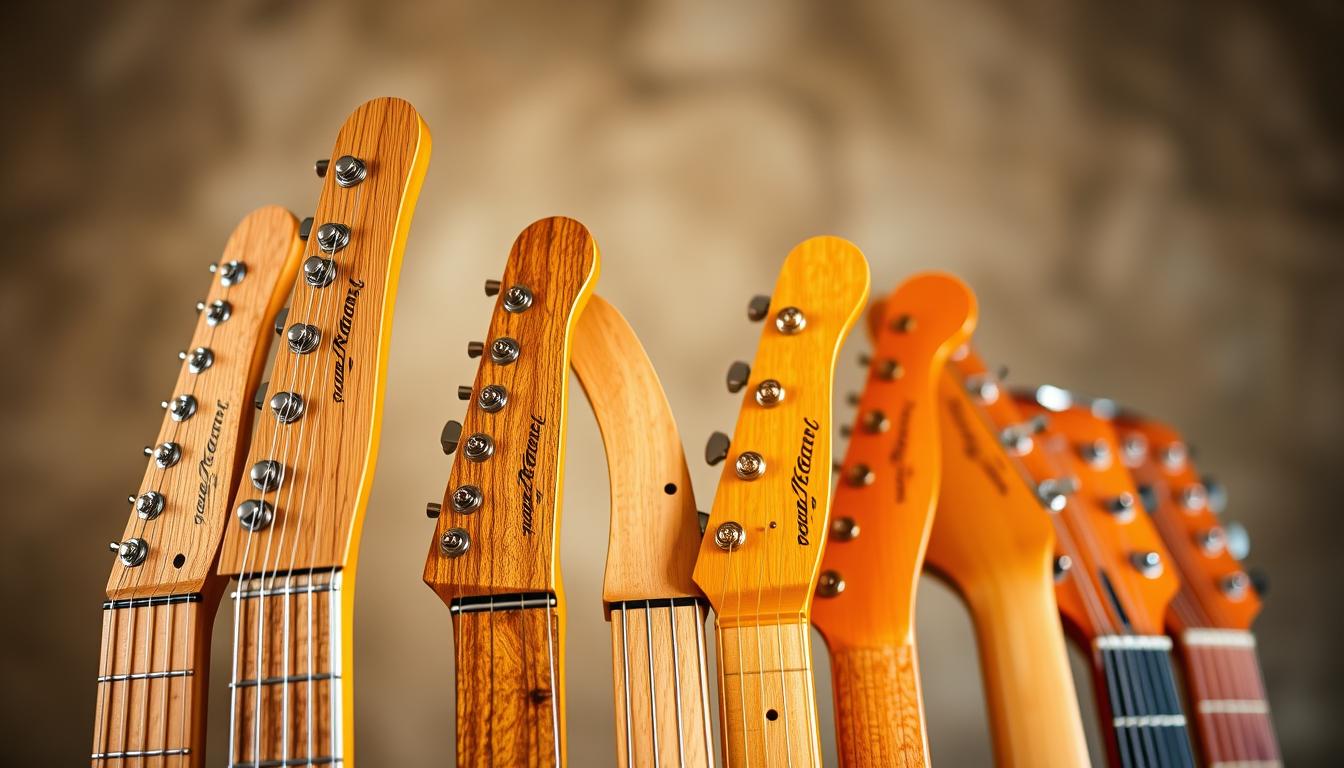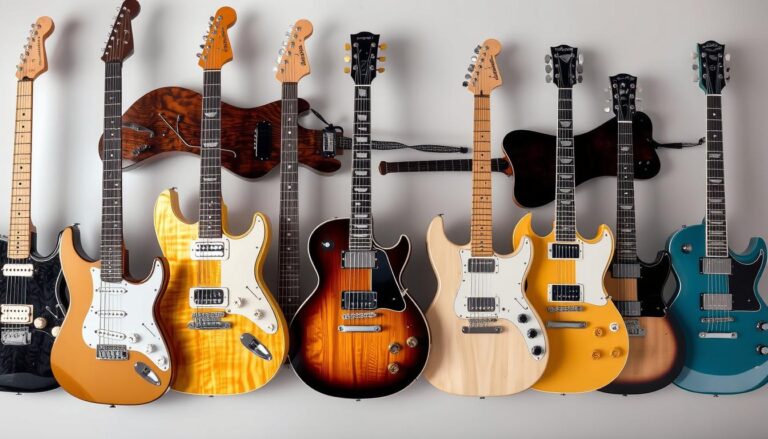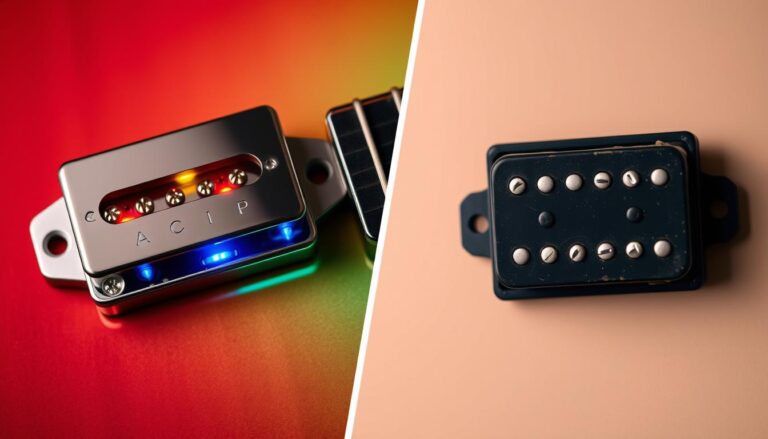Did you know that 40% of guitar players feel uncomfortable because of neck thickness? This can make playing for a long time hard. At Superstar Soundz, we think it’s key to pick the right neck profiles for comfort and playability. We’re here to help you understand the different neck profiles like C, U, V, and D shapes. This way, you can find the perfect fit for your playing style.
Key Takeaways
- About 50-70% of guitar players like the C-shape neck profile for its comfort and versatility.
- 15-30% of players prefer V-shape neck profiles, mainly those who use modern playing techniques.
- U-shape neck profiles are chosen by 10-25% of players, often those with bigger hands.
- 80% of players say comfort is more important than technical specs when picking neck profiles.
- More than 70% of professional luthiers suggest trying different neck shapes before buying a guitar.
- Guitar neck profiles, including shapes and profiles, greatly affect sound quality and playability.
- Knowing the different neck profiles, like C, U, and V shapes, helps you choose the right guitar.
Introduction to Guitar Neck Profiles
We provide top-notch sound and lighting for all kinds of events. We make sure everything runs smoothly and leaves a lasting impression. When it comes to guitar necks, the profile is key. It affects how easy the guitar is to play and how comfortable it feels.
Guitar necks vary in design and size, fitting different playing styles. Bass guitars have thicker necks to handle heavy strings better than standard guitars.
What Are Guitar Neck Profiles?
Guitar neck profiles describe the neck’s shape and size. They can be C, U, or V shapes. The right profile can make playing more comfortable and easier.
Importance of Neck Profile in Playability
The neck profile greatly impacts a guitar’s playability. A well-shaped neck makes playing more enjoyable. But a poorly shaped one can cause discomfort and fatigue.
- C shape: a popular choice among guitarists, known for its comfort and versatility
- U shape: a thicker neck profile, ideal for players with larger hands
- V shape: a unique profile that allows for better thumb-resting techniques and faster playing
Knowing about different neck profiles helps you choose the right guitar. It ensures the guitar fits your playing style and preferences.
Common Guitar Neck Profiles
Finding the right guitar neck profile is key to comfort and playability. Our team works hard to give you the best service and knowledge. We focus on different neck profiles, shapes, and curvatures to help you.
Guitar World says the C-shape neck is the most common today. It’s loved by both new and experienced players for its flexibility. On the other hand, the V-shape neck is great for those who play with their thumb on top. It makes reaching high frets easier for fast solos.
C Shape
The C-shaped neck is popular for its comfort and versatility. It feels balanced, fitting many playing styles. It’s seen as a standard in the guitar world.
U Shape
U-shaped necks are thicker than C profiles. They’re good for players with bigger hands. They offer a chunky feel that many enjoy.
V Shape
V-shaped necks have sharp angles. They make it easy to reach high frets for quick solos. They’re perfect for players who play with their thumb on top.
D Shape
The D-shaped neck is known for its ergonomic design. It has a flat mid-section, making it great for speed and comfort. It’s used in many modern guitars, giving a unique feel.
Knowing about each neck profile helps you choose the right guitar. It’s important to think about your playing style and preferences. This includes considering the neck’s shape and curvature.
Factors Influencing Neck Choice
Choosing the right neck profile for your guitar involves several factors. We serve musicians, DJs, event planners, and more. Luthiers.com says playing style and hand size are key. For example, those with larger hands might prefer U-shaped or D-shaped necks for better grip.
Players with smaller hands might find C-shaped or slim D-shaped necks more comfortable. Playing style also matters. Fast-hand players might like thinner necks, while rhythm players might prefer “chunky C” or V-shaped necks. We offer many neck profiles to fit different styles and hand sizes.
Some popular neck profiles include:
- C-shaped necks, known for their versatility and comfort
- D-shaped necks, preferred by players who require faster hand movements
- U-shaped necks, favored by larger-handed players
We aim to provide the best neck profiles for our customers. Whether you play jazz, rock, or any other genre, we’ve got you covered. Our expertise and innovative solutions will help you find the perfect neck profile for your guitar.
By considering these factors and choosing the right neck profile, you can improve your playing experience. At our company, we’re dedicated to delivering top-notch audio-visual experiences. Whether you’re a seasoned musician or just starting, we’re here to help you find the best neck profiles for your needs.
The Benefits of Different Profiles
Every guitar player is unique, and so are their preferences. At our company, we focus on delivering top-notch audio-visual experiences. We also pride ourselves on our exceptional service and technical skills. Guitar World agrees that the right neck profile can make a big difference. It can offer comfort, ergonomics, and versatility in playing.
Popular neck shapes include the C shape and the D shape. The C shape is versatile, while the D shape is great for lead players. The asymmetrical neck profile has a thinner high E side and a thicker low E side. This design offers comfort and playability. When choosing a guitar, consider the neck curvature and profile. It can greatly affect your playing experience.
Comfort and Ergonomics
Players with small hands might prefer guitars with flatter profiles, like the C shape. This makes it easier to span frets. On the other hand, those with larger hands might like thicker necks, such as the U shape. When picking a neck profile, think about these factors:
- Neck depth: A shallower neck can be more comfortable and easier to play.
- Neck width: A narrower neck is better for players with smaller hands.
- Fretboard radius: A flatter fretboard helps with faster playing and easier navigation.
Versatility in Playing
The right neck profile depends on your personal preference and playing style. Try out different profiles to find what works best for you. With the right profile, you can improve your technique, adaptability, and overall playing experience.
| Neck Profile | Description | Benefits |
|---|---|---|
| C Shape | Versatile and comfortable | Suitable for advanced and beginner players |
| D Shape | Optimal for lead players | Provides stability and comfort |
| Asymmetrical | Thinner high E side and thicker low E side | Provides comfort and playability |
How Neck Profile Affects Tone
We are dedicated to giving our clients the best solutions. We use our knowledge to ensure they have a great experience. The profile of a guitar neck can greatly change the tone and how it feels to play. Luthiers.com says the neck’s profile can alter the guitar’s tone, with different materials and shapes affecting sound.
The material of the guitar neck designs also matters for the tone. A dense hardwood neck can make the sound brighter and more aggressive. On the other hand, a softer wood neck can make the sound warmer and milder. The neck’s shape also plays a part, with different neck profiles creating unique sounds.
There are several guitar neck designs like C-shape, U-shape, V-shape, and D-shape. Each design has its own feel and sound. For instance, the C-shape is known for being comfortable and easy to play. The U-shape is great for those with larger hands. The V-shape is less common but can create a unique sound.
Material Impact
The neck’s material also affects the sound. Different materials can change the tone, and some are better for certain music styles. For example, a mahogany neck is perfect for jazz and blues, giving a warm, rich sound.
Shape and Sound Transmission
The neck’s shape also influences sound transmission. Different profiles can create different tones, and some shapes are better for specific music types. A flat, wide profile, for example, can make the sound bright and aggressive, ideal for rock and metal.
Testing Guitar Neck Profiles
We suggest our clients try out various neck profiles to see which one fits them best. Guitar World says trying different profiles is the best way to find the right one. Think about how the neck’s curve affects how easy it is to play.
In-Store Trials
Going to a music store and trying out guitars with different neck profiles is a great idea. You can play and compare different guitars. This helps you see which neck shape feels best in your hands.
Think about what neck shape works best for you. Do you like a C-shape, U-shape, or V-shape neck?
Online Reviews and Recommendations
Online reviews and advice can also help you find the right neck profile. Many guitarists share their experiences online. This gives you insights into the good and bad of different neck profiles.
You can also talk to a luthier or guitar expert. They can give you personalized advice on the best neck profile for you.
There are a few popular neck shapes. The C-shape neck is versatile and works for many playing styles. The U-shape neck is thicker and broader, great for players with bigger hands.
The V-shape neck is made for fast playing. It also gives better access to the upper frets.
- C-shape neck: versatile and suitable for a wide range of playing styles
- U-shape neck: thicker and broader, ideal for players with larger hands
- V-shape neck: designed for fast playing and provides better access to upper frets
The best neck profile for you depends on your personal taste and playing style. We advise trying out different profiles. Take your time to find the one that feels most comfortable and meets your needs.
Adjusting to a New Neck Profile
Switching to a different neck profile can change how you play. It’s important to think about the guitar neck dimensions and how they impact your style. Adjusting takes time, but with the right help, it can be easier.
Our team is here to help you adjust to a new neck profile. We offer support and guidance. We suggest finding the best neck profile for you, like C-shape, U-shape, or V-shape. This can enhance your playing and improve your music.
Here are some tips for adjusting to a new neck profile:
- Start with small adjustments to the neck profile and gradually work your way up to the desired shape
- Practice regularly to build up your hand strength and dexterity
- Consider consulting with a luthier for tailored guidance based on your individual playing needs
By following these tips and exploring different neck profiles, you can find the perfect fit. Remember, patience, practice, and the right support are key to a successful transition.
| Neck Profile | Description |
|---|---|
| C-shape | Popular and versatile, suitable for smaller hands |
| U-shape | Comfortable for most players, particularlly those who prefer thumb-wrapped techniques |
| V-shape | Speed-enhancing, favored by players who prefer thumb-on-top technique |
Specialty Profiles for Specific Genres
We help musicians from all genres find the right audio and visual tools. Each genre has its own favorite neck shapes and profiles. For example, jazz players like a soft V shape or a C shape with a custom neck profile. This helps with complex fingerings and chord voicings.
Rock and metal fans often choose a bold V shape or a D shape. These shapes give better feedback for fast playing and lead work. The right neck profile can make playing easier and less tiring. Guitar World says different genres need different neck profiles.
Here are some popular neck shapes for different genres:
- Jazz: Soft V shape or C shape with a custom neck profile
- Rock: Pronounced V shape or D shape
- Metal: V shape or U shape with a thicker neck profile
We tailor our neck profiles and curvature to meet each genre’s needs. This improves the playing experience. For more on electric guitars, check out this guide.
Maintenance of Guitar Neck Profiles
We help our clients take care of their guitar neck profiles. Luthiers.com says it’s key to keep them in top shape. This means making adjustments and storing them right to avoid damage.
Adjustments are key for playability and sound. Check the neck relief, action, and string height often. Each neck type needs its own care. For instance, a U-shaped neck might need more tweaks than a C-shaped one.
Storing your guitar right is also important. Use a hardcase and keep it away from extreme weather. Avoid direct sunlight to protect the finish. These steps help your neck last longer and play better.
Regular Adjustments
- Check the neck relief regularly to ensure it’s within the recommended range.
- Adjust the action and string height to achieve the desired playability and sound quality.
- Consider consulting a professional luthier for complex adjustments or repairs.
Proper Storage Techniques
- Store the guitar in a hardcase to protect it from damage and scratches.
- Keep the guitar away from extreme temperatures and humidity to prevent warping or cracking.
- Avoid exposure to direct sunlight, which can cause fading or discoloration of the finish.
| Neck Profile | Adjustment Frequency | Storage Requirements |
|---|---|---|
| U-shaped | More frequent | Hardcase, away from direct sunlight |
| C-shaped | Less frequent | Hardcase, moderate temperature and humidity |
Conclusion: Finding Your Ideal Neck Profile
The guitar neck profile you choose greatly affects your playing experience and sound quality. Whether you like the classic C-shape, the chunky U-shape, or the sharp V-shape, the best neck profiles offer comfort and versatility. They fit your playing style and hand size perfectly.
Guitar World says the right guitar neck curvature can really change how you play and the sound you get. Each popular neck shape has its own benefits. For example, the C-shape is versatile, while the V-shape is great for thumb fretting. By trying different profiles, you’ll find the one that feels natural and enhances your music.
Finding the right neck profile is a personal choice. What’s best for one guitarist might not be for another. So, explore, experiment, and listen to your instincts. This way, you’ll find the guitar neck that lets you play your best and enjoy making music.




